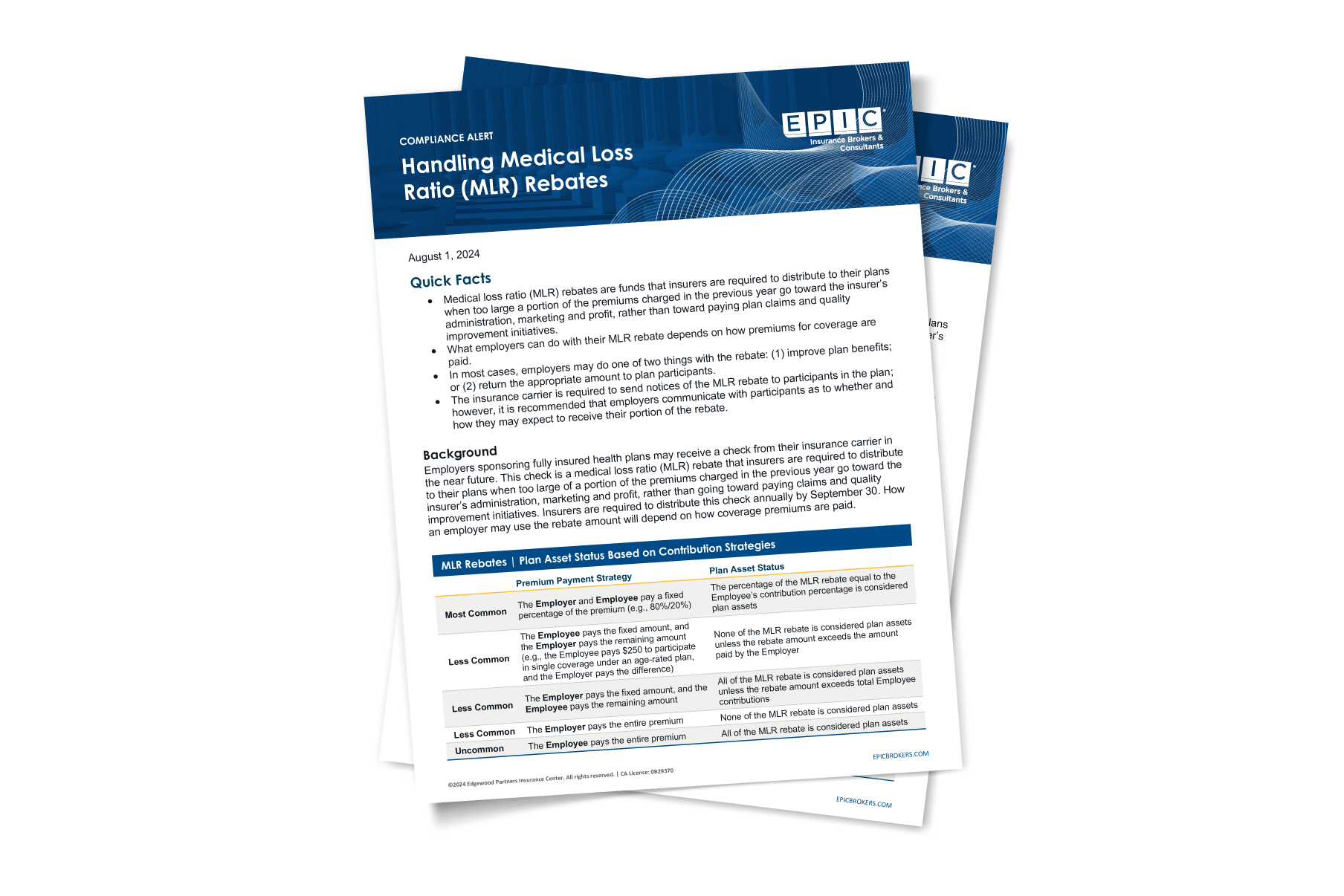Let our team help you navigate the ever-changing benefits compliance landscape each month. Check out this month’s latest alerts, additional updates, and resources hot off the press:
Employee Benefits Compliance Alerts
This month’s Compliance Matters newsletter provides a comprehensive review of the following topics. To obtain your copy, please use the form below to download.

- Special Compliance Alert: The One Big Beautiful Bill Impacts Employer-Sponsored Health & Welfare Programs
- SCOTUS Denies Review of Mulready PBM Case
- CMS Medicare Secondary Payer Data Match
- 2025 State Regulation Series: Iowa Governor Signs Legislation Limiting PBMs & Impacting Health Plans
- 2025 State Regulation Series: Indiana Senate Bill 140 Introduces New PBM Regulations
- Opting Out of State PBM Investigations & Reporting
- Employee Benefits Litigation Series: Anthem Settles Mental Health Parity Class Action M
Download this month’s alerts
Additional Updates & Resources
ACA Affordability Percentage for 2025
On July 18, 2025, the Internal Revenue Service (IRS) issued Revenue Procedure 2025-25, which updated the Affordable Care Act (ACA) affordability percentage from 9.02% for 2025 to 9.96% for 2026. The updated percentage is the highest the ACA affordability percentage has been since its first year in 2015. The updated percentage will put the threshold for employee premiums to remain affordable at just under $130 per month.
This percentage determines which applicable large employers (ALEs) may face penalties under ACA §4980H(b) for failure to offer affordable coverage, as well as which individuals may qualify for subsidized coverage through a public Exchange. When setting plan contribution rates, employers must consider IRS employer affordability safe harbors, the various elements that play into determining employee contributions and the penalties for failing to offer affordable coverage.
Under §4980H (the employer mandate), ALEs (those with 50 or more full-time equivalents [FTEs]) must offer coverage to full-time employees that is affordable to avoid potential penalties. In addition, individuals enrolling in coverage through a public Exchange will not qualify for subsidized coverage (premium tax credits) if they are eligible for employer-sponsored group health plan coverage that is affordable.
Coverage is considered “affordable” if the required employee contribution does not exceed a set percentage (9.96% in 2026) of household income.
- For employees, coverage is affordable if the required employee contribution for the lowest cost minimum value plan for employee-only (single) coverage is affordable.
- For spouses and dependents, coverage is affordable if the required employee contribution for the lowest cost minimum value plan for family coverage is affordable. Note that penalties under the ACA for failure to offer affordable coverage do not apply to spouses and dependents.
Coverage is also considered “affordable” under employer mandate requirements if the employee contribution satisfies at least one of three available safe harbors (i.e., federal poverty level [FPL]), rate of pay, or Form W-2). However, it is not always financially advantageous for the employer to ensure that the coverage offered is affordable to all full-time employees. Employers should consider the §4980H(b) monthly penalty for a full-time employee receiving a subsidy. The employer contribution for employees who enroll in the employer’s plan may be more than the employer would be required to pay as a penalty under §4980H(b).
ACA Employer Mandate Penalties Updated for 2026
In July, the Internal Revenue Service (IRS) released IRS Revenue Procedure 2025-26, which provides updated penalties for applicable large employers (ALEs) with 50 or more full-time equivalent (FTE) employees under the employer shared responsibility provisions (employer mandate) of the Affordable Care Act (ACA). For the calendar year 2026, penalty A (the penalty for not offering coverage to at least 95% of FTEs) will be $3,340, and penalty B (the penalty for not offering coverage that is affordable or minimum value) will be $5,010.
The revenue procedure is effective for taxable years and plan years beginning after December 31, 2025.
California Mandated Fertility Coverage Delayed
Last month, we sent an alert that the California mandated fertility coverage requirement, set to be effective for plan years starting on or after July 1, 2025, may be delayed. Late on June 30, 2025, Governor Newsom signed the omnibus trailer bill that delayed the mandate until January 1, 2026. If they haven’t already, carriers should be adjusting rates accordingly for 7/1 to 12/1 renewals. For fully insured calendar year plans in California, there should be minimal impact as these plans would not see this mandate effective until January 1, 2026, regardless of the delay.
Site-Neutral Payment Rules & Price Transparency
On July 15, the Centers for Medicare and Medicaid Services (CMS) issued a proposed rule that proposes updates to Medicare payment policies and rates for hospital outpatient and Ambulatory Surgical Center (ASC) services. CMS is proposing to apply the Physician Fee Schedule equivalent payment rate for any procedure codes assigned to the drug administration ambulatory payment classifications (APCs) when provided at an off-campus provider-based department. This would have the effect of bringing the cost of drug administrative services provided in outpatient hospital facilities in line with the amount paid to physician offices. Beginning in 2026, the lower physician office rate would apply to outpatient hospital facilities that were previously exempt from a 2015 law. They estimate this provision will reduce the Outpatient Prospective Payment System (OPPS) spending by $280 million, with $210 million of the savings accruing to Medicare, and $70 million saved by Medicare beneficiaries in the form of reduced beneficiary coinsurance.
Several of the provisions mirror similar site-neutral payment policies that were included in the Lower Cost, More Transparency Act, which passed the House in 2023, but did not become law. The rule would also require hospitals to post prices online in a way that helps patients understand what their care will actually cost. This addresses criticism that the information hospitals have been required to post since 2021, as part of hospital price transparency regulations, is not easy for patients to understand.
California Victims Coverage Now in Effect
Enacted on July 1, 2025 this law requires a health insurance policy that is fully insured in the state of California delivered on or after July 1, 2025, to provide coverage without cost sharing for emergency room medical care and follow up healthcare treatment for an enrollee or insured who is treated following a rape or sexual assault for the first nine months after the enrollee initiates treatment, as specified. The law prohibits a health insurer from requiring, as a condition of providing coverage:
- An enrollee or insured to file a police report,
- Charges to be brought against an assailant, or
- An assailant to be convicted of rape or sexual assault.
A violation of the bill by a healthcare service plan or issuer is a crime in the state of California.
Monthly FAQ: What are the requirements for covering a dependent child to age 26?
A group health plan or insurer that provides dependent coverage for children generally must make the coverage available until a participant’s child turns age 26. Factors such as residency, age, income, and marital/tax filing status are disallowed as eligibility conditions for purposes of the age 26 mandate.

More Compliance Resources
- Sign up for our in-depth Compliance Webinars
- Learn about our Compliance Consulting Services

WANT TO GET COMPLIANCE MATTERS IN YOUR INBOX?
Sign up for the monthly newsletter.